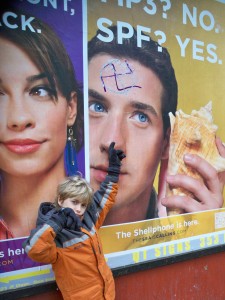 While walking with my 8-year-old son near our home in Manhattan, he spotted a purple swastika scrawled across a billboard advertisement. As I took in the complexities of the situation, my son uttered words that made my heart break…
While walking with my 8-year-old son near our home in Manhattan, he spotted a purple swastika scrawled across a billboard advertisement. As I took in the complexities of the situation, my son uttered words that made my heart break…
Across the nation, anti-Semitic bias cases have been capturing news headlines. Last month, two men from Farmington, New Mexico were sentenced to time in federal prison for branding a swastika on the arm of a Navajo man who suffers from mental disabilities. Swastikas were found graffitied on storefronts and homes across the New York metropolitan area, and a teenager has been charged with throwing Molotov cocktails at a synagogue in New Jersey, igniting a fire in the residence of the rabbi and his family.
The rash in anti-Semitic incidents prompted many leaders to talk about the need to “speak up and condemn these vulgar crimes” and to “respond forcefully.” But how do you respond to bias when you’re with your young child, and the crime is in your own neighborhood?
I was recently faced with this question while walking with my eight-year-old son down a street near our home in downtown Manhattan. He was the first to spot it — a purple swastika scrawled across the forehead of a man on a billboard advertising a cruise line.
“Isn’t that a swastika?” he demanded, pointing.
“Yes – it definitely is,” I answered. “Where have you seen one before?”
“Raiders of the Lost Ark,” he said, staring up at the graffiti.
I was quickly taking in the complexities of the situation and what to say next when he said sadly, “The person who did that hates me, and he doesn’t even know me.”
You don’t have to be raising a Jewish child to understand the heartbreak in those words. As I took his hand and we continued on our way home, I told him a somewhat disjointed story about my own understanding of the swastika and what it stands for.
I told him about how confused I felt when I first saw an ancient swastika carved on a temple in Thailand in my post-college backpacking days. And how the symbol, which originally had a positive, sacred meaning in Hindu, Buddhist and other traditions, was turned on its side (literally) by the Nazis and became a mark of Aryan supremacy.
This led to a discussion of Hitler’s view of a master race, which is pretty tough to explain to a blonde-haired, blue-eyed Jewish child (a friend fondly refers to him as “the Jewish Viking.”) I was careful not to alarm him, but I wanted to be accurate and honest.
I am admittedly not an historian nor an expert on current day hate symbols, but we seldom wear our professional hats when talking to our children anyhow. What I began to see was that he needed to have a sense of control over what he had just seen. My telling him I was going to call the City’s 311 information hotline to report it wasn’t going to be enough.
“So what do you want to do about the swastika?” I asked.
“Let’s get a can of black spray paint and cover it over,” he suggested.
“That might feel good,” I said. “But wouldn’t we be destroying something that doesn’t belong to us?”
“We could put something good over it,” he said thoughtfully.
I couldn’t imagine what that could be, but listened anyhow. Sometimes a child’s internal compass points them to their own true north, and it’s best for us adults to get out of their way. Armed with colored paper and markers, he came up with this…
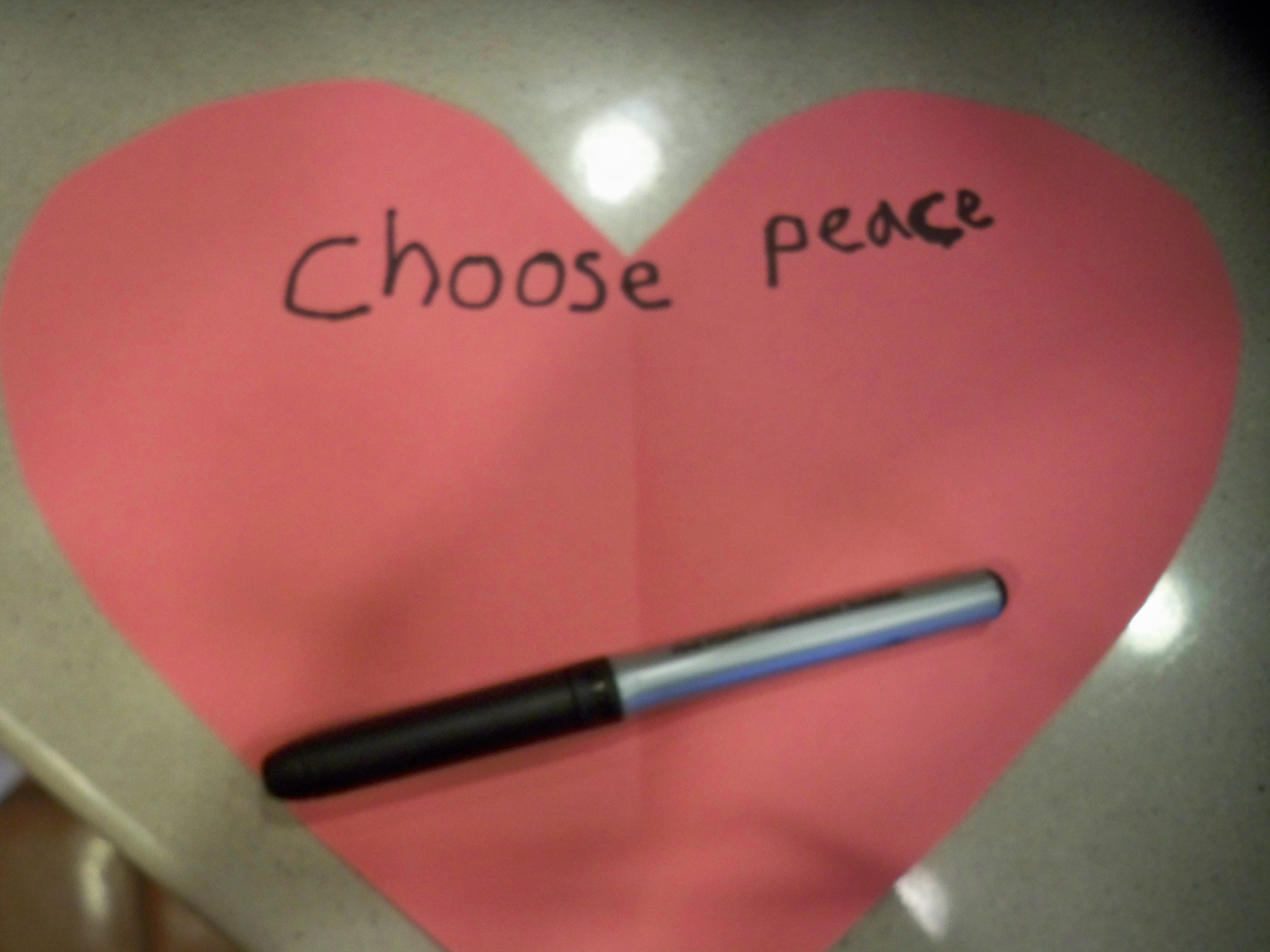 Which I lifted him up to tape on the billboard the following day…
Which I lifted him up to tape on the billboard the following day…
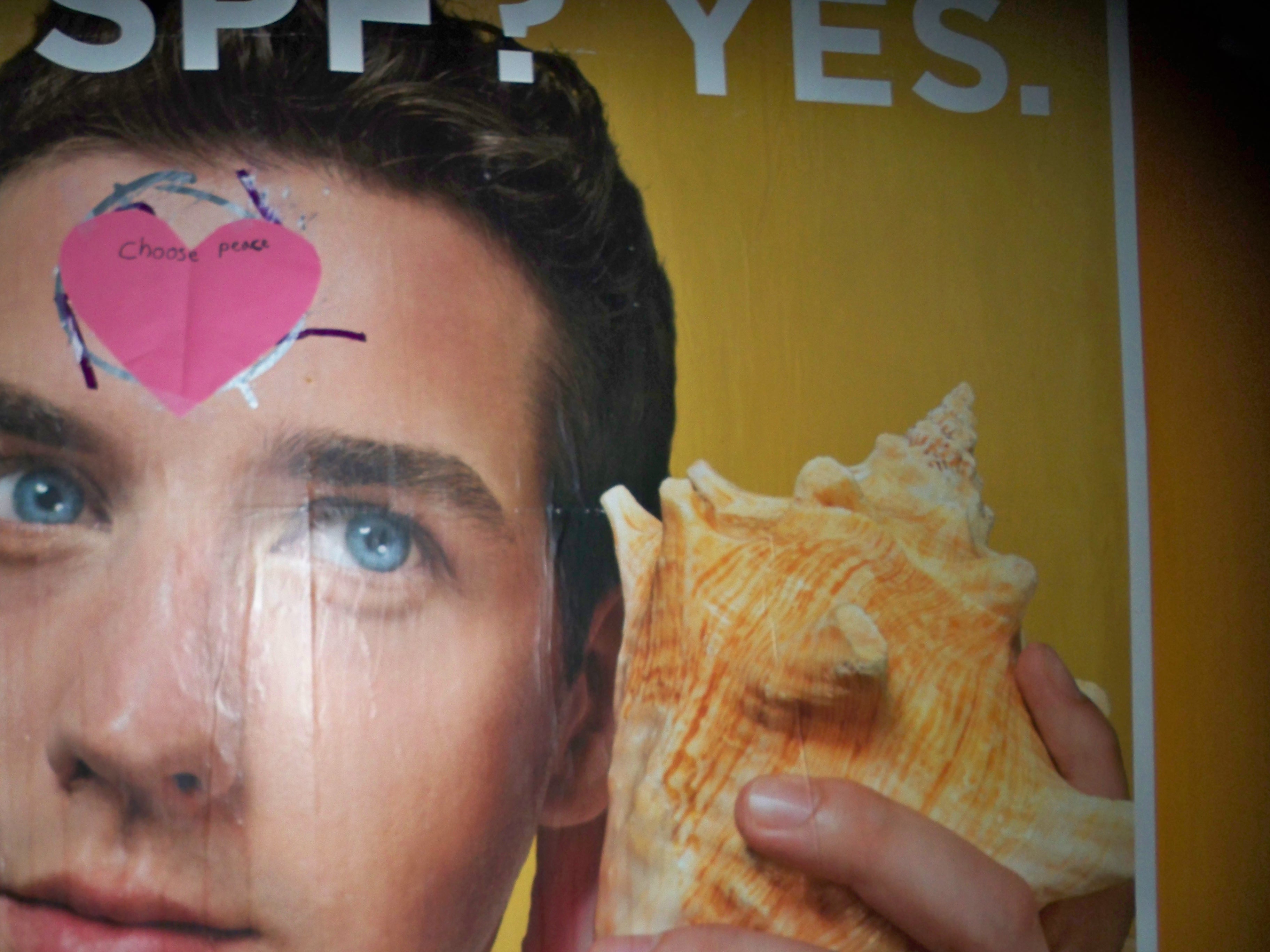
Clearly this is just a beginning. Anti-Semitic acts and other signs of hatred will not vanish over night, and our conversations and responses will evolve with each passing day. But the important thing is to keeping talking and to always, always respond.
For more information:
The Anti-Defamation League has an on-line resource called Discussing Hate and Violence with your Children which includes advice from Dr. Donald J. Cohen, Director of Yale Child Study Center and Professor of Child Psychiatry, Pediatrics and Psychology at Yale University.
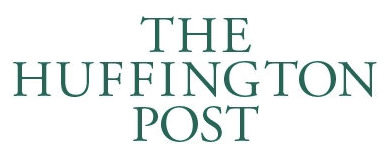



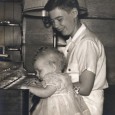

Thank you for sharing this lesson. It made my day.
Thanks so much for reading!
Now you’re making me cry again, Barbara! Such a thoughtful, well-written piece. I love your son’s idea to cover it with “choose peace” – a true sign that you are raising a conscientious, well-adapted kid.
Of course, kids being kids, I had to laugh this morning when he was being pure devil at the breakfast table. If he only knew people were saying nice things about him 😉
great story, your son is wise beyond his years. As someone born and raised in Germany, I spent my childhood years coming to terms with falling on the oppressor side of history’s long road of human confusion. As you say, there are many layers to the swastika, from its auspicious origins to its archetypal shift in the western world during the Nazi years. I’m not sure if it’s possible to reclaim it as an auspicious symbol, but I do think it can serve the higher purpose of symbolizing the difficult but necessary processing of the deepest and darkest wounds we humans are capable of holding inside. If you’re interested, I wrote about my own inner process in regard to my country’s and family’s history here.
Friends – do yourself a favor and read Sven’s article, posted above. There’s such incredible honesty in confronting his grandfather’s Nazi past. Very thoughtful and difficult work, Sven.
Just beautiful. Children sometimes (despite being horrid at mealtimes!) really do come up with the perfect responses. Of course, I think your willingness to guide him (the black paint, waiting) had a lot to do with it. A pistols to plowshares moment.
Nearly every day brings a teaching moment; this was an exceptionally powerful one. As usual, you handled it beautifully. Love Drew’s heart.
The person who vandalized the sign does not realize that the German national socialist symbol was pointed in the S-letter direction to symbolize crossed S-letters for socialism. See the work of the symbologist Dr. Rex Curry. German national socialists did not call their symbol a swastika. They called it a hakenkreuz (hooked cross) because it was a type of cross and used as crossed S-letters by them. The word swastika was substituted for hakenkreuz or hooked cross by ignorant people to defame a different foreign symbol in order to distance German national socialism from the Christian cross. Please help educate everyone.
Why dont you write an article about what the real and original meanings of the swastika are. It is an ancient symbol and was around long before the Nazi adopted it and corrupted the meaning. Stop giving it life as something evil and educate people.
Barb, what can I say that hasn’t already been said. What a beautiful piece that reflects the beauty and soul of you and your family’s values. I’m so intrigued to know what this boy will grow up to become.
Thank you for sharing D’s wisdom. I’m gonna share it now…
Thanks for sharing! Beautiful post!
Thank you all for responding to this piece! I, too, am confronted by the violence inherent in corrupting an ancient symbol of prosperity and higher energy. It would be extremely hard to reclaim it in this culture, at this time. Whoever wants to take that one can certainly try! But in this case, as a commenter said elsewhere, I highly doubt the vandal was running around a Jewish neighborhood putting up ancient spiritual symbols as a sign of peace and kindness for the world to see.
I feel so lucky to be this kid’s mom (most of the time 😉 )
Best wishes to you all,
Barbara
Barbara, thanks for educating me. When you write that we should “always, always respond,” I realized that my method is usually to let it pass, on the theory that I can’t do anything about the hatred that inspired the vandalism. I stand corrected. Irene
Thank you, Irene! I probably wrote that because I needed to remind myself as well. Every walk outside the apt in NYC brings some situation to respond to, whether it’s homelessness or graffiti It can feel overwhelming sometimes, can’t it? That’s why I’m so grateful for my kids, for teaching ME!
This story stopped my heart when you read it aloud and the ending, about how your son turned a terrible symbol of hate into a symbol of hope, made me cry. I’m glad your essay reached such a broad audience at BlogHer.
Thank you so much, Jessica! All the kudos belong to my little guy, really. When I remember to stop, I learn from him every day.
I just wanted to tell you, too, that I was reading through your blog and love what you’re doing. I think you should go for your anthology in spite of the words of caution. I think MediaBistro may even have a class on anthologies. Check it out, and keep going! Looking forward to hearing more.